Catherine Palace
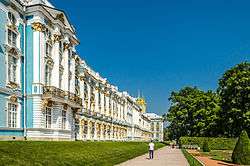
The Catherine Palace (Russian: Екатерининский дворец, Yekaterininskiy dvorets) is a Rococo palace located in the town of Tsarskoye Selo (Pushkin), 30 km south of St. Petersburg, Russia. It was the summer residence of the Russian tsars.
History
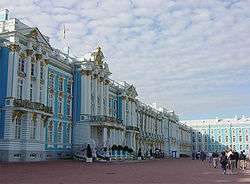

The residence originated in 1717, when Catherine I of Russia hired German architect Johann-Friedrich Braunstein to construct a summer palace for her pleasure. In 1733, Empress Elizabeth commissioned Mikhail Zemtsov and Andrei Kvasov to expand the Catherine Palace. Empress Elizabeth, however, found her mother's residence outdated and incommodious and in May 1752 asked her court architect Bartolomeo Rastrelli to demolish the old structure and replace it with a much grander edifice in a flamboyant Rococo style. Construction lasted for four years, and on 30 July 1756 the architect presented the brand-new 325-meter-long palace to the Empress, her dazed courtiers, and stupefied foreign ambassadors.
More than 100 kilograms of gold were used to gild the sophisticated stucco façade and numerous statues erected on the roof. In front of the palace a great formal garden was laid out. It centres on the azure-and-white Hermitage Pavilion near the lake, designed by Mikhail Zemtsov in 1744, remodelled by Francesco Bartolomeo Rastrelli in 1749 and formerly crowned by a grand-gilded sculpture representing The Rape of Persephone. The interior of the pavilion featured dining tables with dumbwaiter mechanisms. The grand entrance to the palace is flanked by two massive "circumferences", also in the Rococo style. A delicate cast-iron grille separates the complex from the town of Tsarskoe Selo.
Although the palace is popularly associated with Catherine the Great, she actually regarded its "whipped cream" architecture as old-fashioned. When she ascended to the throne, a number of statues in the park were being covered with gold, in accordance with the last wish of Empress Elizabeth, yet the new monarch had all the works suspended upon being informed about the expense. In her memoirs she censured her predecessor's reckless extravagance:
- "The palace was then being built, but it was the work of Penelope: what was done today, was destroyed tomorrow. That house has been pulled down six times to the foundation, then built up again till it was brought to its present state. The sum of a million six hundred thousand rubles was spent on the construction. Accounts exist to prove it; but besides this sum the Empress spent much money out of her own pocket on it, without ever counting".
In order to gratify her passion for antique and Neoclassical art, Catherine employed the Scottish architect Charles Cameron, who not only refurbished the interior of one wing in the Neo-Palladian style then in vogue, but also constructed the personal apartments of the Empress, a rather modest Greek Revival structure known as the Agate Rooms and situated to the left of the grand palace. Noted for their elaborate jasper decor, the rooms were designed so as to be connected to the Hanging Gardens, the Cold Baths, and the Cameron Gallery (still housing a collection of bronze statuary)—three Neoclassical edifices constructed to Cameron's designs. According to Catherine's wishes, many remarkable structures were erected for her amusement in the Catherine Park. These include the Dutch Admiralty, Creaking Pagoda, Chesme Column, Rumyantsev Obelisk, and Marble Bridge.
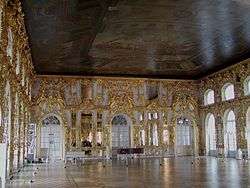
Upon Catherine's death in 1796, the palace was abandoned in favour of Pavlovsk Palace. Subsequent monarchs preferred to reside in the nearby Alexander Palace and, with only two exceptions, refrained from making new additions to the Catherine Palace, regarding it as a splendid monument to Elizabeth's wealth and Catherine II's glory. After the Great Fire of 1820, Alexander I engaged Vasily Stasov to refurbish some interiors of his grandmother's residence in the Empire style. Twenty years later, the magnificent Stasov Staircase was constructed to replace the old circular staircase leading to the Palace house church (ru:Церковь Екатерининского дворца). Unfortunately, most of Stasov's interiors—specifically those dating from the reign of Nicholas I—have not been restored after the destruction caused by the Germans during World War II.
When the German forces retreated after the siege of Leningrad, they intentionally destroyed the residence. [1] leaving only the hollow shell of the palace behind. Prior to World War II, Soviet archivists managed to document a fair amount of the interior, which proved of great importance in reconstructing the palace. Although the largest part of the reconstruction was completed in time for the Tercentenary of St. Petersburg in 2003, much work is still required to restore the palace to its former glory. In order to attract funds, the palace's administration has leased the Grand Hall for such high-profile events as Elton John's concert for an elite audience in 2001 and an exclusive party in 2005 featuring the likes of Bill Clinton, Tina Turner, Whitney Houston, Naomi Campbell, and Sting.
Layout
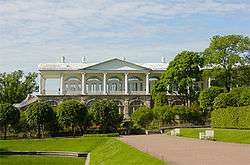

Although Stasov's and Cameron's Neoclassical interiors are superb manifestations of late 18th-century and early 19th-century taste, the palace is best known for Rastrelli's grand suit of formal rooms known as the Golden Enfilade. It starts at the spacious airy ballroom, the "Grand Hall" or the "Hall of Lights", with a spectacular painted ceiling, and comprises numerous distinctively decorated smaller rooms, including the reproduced Amber Room.
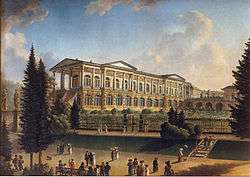
The Great Hall, or Light Gallery, as it was called in the 18th century, is a formal apartment in the Russian baroque style designed by Bartolomeo Rastrelli between 1752 and 1756.[2] The Great Hall was intended for more important receptions such as balls, formal dinners, and masquerades. The hall was painted in two colors and covers an area of approximately 1,000 square meters. Occupying the entire width of the palace, the windows on the eastern side look out onto the park while the windows of the western side look out to the palace plaza. In the evening, 696 lamps are lit on 12-15 chandeliers located near the mirrors. The hall's sculptural and gilded carvings and ornamentation were created according to sketches by Rastrelli and models by Johann Franz Dunker.
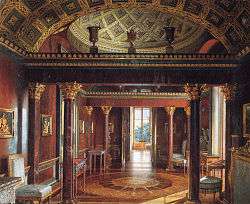
Beyond the Great Hall is the dining room for the courtiers in attendance (the Courtiers-in-Attendance Dining Room). The room was designed by Rastrelli in the mid-18th century. The small room is lit by four windows which look out into the formal courtyard. The architect placed false windows with mirrors and mirrored glass on the opposite wall, making the hall more spacious and bright. Decorated in the typical baroque interior style, the hall is filled with gilded wall-carvings, complex gilded pieces on the doors, and ornamental patterns of stylized flowers. The ceiling mural was painted by a well-known student of the Russian School from the mid-18th century. It is based on the Greek myth of the sun god Helios and the goddess of the dawn, Eos.
Across from the Courtiers-in-Attendance Dining Room, on the other side of the Main Staircase, is the White Formal Dining Room. The hall was used for the empresses' formal dinners or "evening meals". The walls of the dining hall were decorated with the utmost extravagance with gilded carvings. The furnishings consist of gilded carvings on the consoles. Some of the furniture which can be seen in the room today is original whilst other pieces are reproductions.[3] The painted mural, The Triumph of Apollo is a copy of a painting completed in the 16th century by Italian artist, Guido Reni.
The Portrait Hall is a formal apartment covering 100 square meters. The room's walls boast large formal portraits of Empress Catherine I and Empress Elizabeth Petrovna, as well as paintings of Natalya Alexeyevna, sister of Peter the Great, and Empress Catherine II.[4] The inlaid floors of the hall contain precious woods. The Drawing Room of Alexander I was designed between 1752 and 1756 and belonged to the Emperor's private suite. The drawing room stood out from the rest of the formal rooms in the palace due to the fact that the walls were covered in Chinese silk. Other decor in the room was typical for the palace's formal rooms−a ceiling mural and gilded carvings. The elegant card tables and inlaid wood commode display Japanese, Chinese, and Berlin porcelain.
The Green Dining Room, which replaced Rastrelli's "Hanging Garden" in 1773, is the first of the rooms in the northern wing of the Catherine Palace, designed by Cameron for the future Emperor Paul and his wife. The room's pistachio-coloured walls are lined with stucco figures by Ivan Martos. During the great fire of 1820 the room was seriously damaged, thus sharing the fate of other Cameron interiors. It was subsequently restored under Stasov's direction.[5]
Other interiors by Cameron include the Waiters' Room, with an inlaid floor of rosewood, amaranth and mahogany and stylish Chippendale card tables; the Blue Formal Dining-Room, with white-and-blue silk wallpaper and Carrara marble chimneys; the Chinese Blue Drawing Room, a curious combination of Adam style with Chinoiserie; the Choir Anteroom, with walls lined in apricot-colored silk; and the columned boudoir of Alexander I, executed in the Pompeian style.
See also
References
- ↑ The palace was used as barracks and for target practice. Before retreating, the Germans set the palace ablaze (Edmund Stevens, Russia Is No Riddle, Kessinger Publishing, 2005, page 184). After the Soviets retook Tsarskoe Selo, "the Catherine Palace presented a terrible scene. The great hall, the picture gallery and the gala staircase had all collapsed... The Amber Room had been stripped and the gala rooms gutted by a fire... A most terrible sight was Ratsrelli's vista of golden doorways, now reduced to raw bricks laden with snow. Cameron's classic suite of rooms was not destroyed but had been much vandalised", etc. Quoted from: Christopher Morgan, Irina Orlova. Saving the Tsar's Palaces. Polperro Heritage Press, 2005. Page 74.
- ↑ http://eng.tzar.ru/museums/palaces/c_atherine/great_hall
- ↑ http://eng.tzar.ru/museums/palaces/c_atherine/white_dining_room
- ↑ http://eng.tzar.ru/museums/palaces/c_atherine/portrait_hall
- ↑ http://eng.tzar.ru/museums/palaces/c_atherine/green_dining_room
External links
| Wikimedia Commons has media related to Catherine Palace. |
- Official website
- Detailed description and history from Tsarskoe Selo in 1910
- Photo Tour of the Cameron Gallery from the Alexander Palace Time Machine
- Charles Cameron - Imperial Architect site on his work in Tsarskoe Selo and the Catherine Palace
- Laskin, David (2006-06-18). "History Is Perennial in the Gardens of the Great Czars". New York Times. Retrieved 2006-12-15.
- Photos of the Catherine Palace interiors
- The Catherine Palace ceiling and wall decorations
- Photos and How to visit
Coordinates: 59°42′57″N 30°23′44″E / 59.71583°N 30.39556°E

